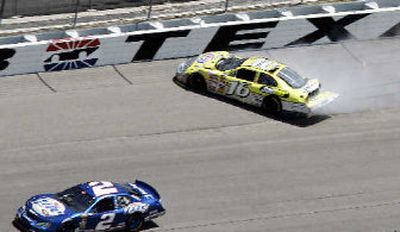Don’t get complacent

DALLAS – The fear factor is missing today in NASCAR, and that’s a bad thing.
Crash your car into the wall and walk away without a scratch. That’s a good thing, but it comes with a downside.
Aggressive driving is at an all-time high because the possibility of getting hurt doesn’t seem real. Safety in NASCAR has progressed to the point where drivers, especially the younger ones, have a sense of invincibility.
Half the field in the Samsung/RadioShack 500 wasn’t racing Nextel Cup when Dale Earnhardt was killed at Daytona in 2001.
Many of them never have been involved in a race when a driver lost his life.
Some of them never have seen a driver seriously injured.
No driver has died in a NASCAR event in the last five years. The only serious injury in a Cup race was Jerry Nadeau’s head trauma in a crash at Richmond in 2003, the year before the SAFER barrier was installed.
The collapsible barrier is the greatest safety advancement in racing history, and the drivers know it. Softer walls, head and neck restraints and other major advances have revolutionized safety in NASCAR.
But it also has produced a bumper-car mentality. Running into another car has no physical consequence. That’s untrue, of course, but if a driver never has seen anything different, why would he think otherwise?
The illusion continues to grow.
Even Paul Dana’s death three weeks ago in the season-opening IRL event didn’t have a major effect on NASCAR drivers. Indy car racing today on oval tracks is far more dangerous than stock car racing.
So the Dana tragedy brought more of a “that’s them, not us” thought process.
It wasn’t that long ago when the possibility of serious injury was part of every NASCAR race. Drivers respected the danger. They knew their lives were on the line every lap.
Too many drivers fail to see it that way now. Danger is just a word. Crashing is something that tears up your car, not your body.
The result of that flawed logic has caused a loss of respect for each other on the track.
Bumping and banging into other cars, even at high-speed oval like Texas Motor Speedway, is common. You hit me and I’m going to hit you twice as hard.
Kurt Busch is viewed as the worst offender, but he’s not alone. At TMS last weekend we saw Busch tag Greg Biffle’s rear bumper and Sterling Marlin do the same to Ryan Newman.
The driver getting rammed still gets mad. The driver initiating the contact always says he didn’t mean to do it.
But it keeps happening because drivers are more aggressive and take more chances. They put themselves in position to cause more incidents.
If you ask them, drivers still say they are conscious of the risks that come with the sport. Maybe it’s the subconscious they should worry about.
What they say and what they do don’t line up.
“And you can’t control what they do out there,” Jeff Gordon said.
Driver etiquette has changed. A gentlemen’s agreement existed in the past to limit when and where you rubbed fenders.
Courtesy no longer applies. Get out of the way or get taken out.
Even at Daytona and Talladega – NASCAR’s two most dangerous tracks – some drivers feel bullet-proof. It took Tony Stewart’s “We’re going to kill somebody” speech this year at Daytona to bring everyone back to reality.
At least for a moment. One week after his warning, Stewart put Matt Kenseth into the wall during the Daytona 500.
The overly aggressive driving could get worse next year when the so-called Car of Tomorrow – a safer machine than the one NASCAR now uses – makes its debut.
It’s a wonderful thing that safety in NASCAR has reached the point where no one expects a tragic outcome. But the perception has led to complacency, a driver’s biggest enemy.
The chance of a tragic outcome has diminished, but it still exists.
The more drivers ignore it and race beyond sensible behavior, the more likely they are to learn the truth.